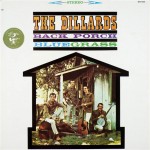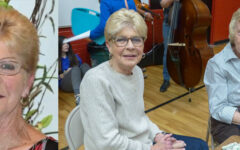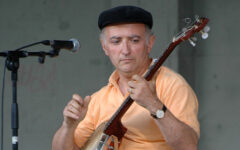
 After the death of Earl Scruggs and the announced retirement of J. D. Crowe, the banjo world suffered another loss last week with the passing of Doug Dillard.
After the death of Earl Scruggs and the announced retirement of J. D. Crowe, the banjo world suffered another loss last week with the passing of Doug Dillard.
Having been seen by millions, perhaps 100 million, through nearly 50 years of Andy Griffith Show reruns, Doug Dillard established his place in the history of bluegrass banjo. However, because much of the mainstream bluegrass world was oriented to groups in the eastern region in the 1960’s and 70’s, and Dillard explored the world outside traditional bluegrass in much of his early career, I must confess that I did not fully appreciate the magnitude of his career at the time, and did not know or understand the contributions he made not only to bluegrass, but to other musical genres.
Born March 6, 1937 in Salem, Missouri, as the middle son of a musical family, Douglas Dillard first began playing guitar at age five. He received his first banjo as a Christmas present at the age of fifteen, and, like most young banjo players in the early 1950’s, credited Earl Scruggs, Don Reno, and Ralph Stanley as his major influences. He reportedly had the oft-told experience of running his car in a ditch the first time he heard Earl Scruggs on the radio.
Doug began his musical career playing in the family band, which included his father Homer, Sr. on fiddle, his mother Lorene on guitar, and older brother Earl on keyboards. In the mid-to-late 1950’s, Doug played in several groups, including the Dixie Ramblers, which also included his younger brother, Rodney, on guitar.
 Eventually, Rodney and Doug struck out on their own and formed the band that most will recall, including Dean Webb on mandolin, and Mitch Jayne on bass. This version of the Dillards played their first concert at Washington University in St. Louis in 1962, one of the earliest bluegrass concerts on a college campus, recorded and released 37 years later on a CD titled The Dillards: a long time ago, The First Time Live.
Eventually, Rodney and Doug struck out on their own and formed the band that most will recall, including Dean Webb on mandolin, and Mitch Jayne on bass. This version of the Dillards played their first concert at Washington University in St. Louis in 1962, one of the earliest bluegrass concerts on a college campus, recorded and released 37 years later on a CD titled The Dillards: a long time ago, The First Time Live.
In the closest thing to an overnight success as the bluegrass world has probably ever seen, the Dillards decided the same year to relocate to the west coast, and shortly after arriving they heard about a hotspot for folk music, the legendary Ash Grove nightclub. They went, got up on stage after the night’s scheduled entertainment had ended, were seen by a representative of Elektra Records, and by the next night were signed to a three album deal with Elektra Records — the stuff musicians’ dreams are made of.
 Their Elektra debut release was the legendary Back Porch Bluegrass, which included Dooley, Banjo In The Hollow, Old Home Place, and Doug’s Tune, among others.
Their Elektra debut release was the legendary Back Porch Bluegrass, which included Dooley, Banjo In The Hollow, Old Home Place, and Doug’s Tune, among others.
The following year, they were cast in recurring roles as the Darlin Family on the Andy Griffith Show, leading to numerous other television appearances, including special shows hosted by Judy Garland and Tennessee Ernie Ford.
During this time, the Dillards appeared at numerous folk festivals, including the Newport Folk Festival at which Bill Monroe and the Stanley Brothers also appeared, and they toured with Bob Bylan, Joan Baez, and many others. In the mid-1960’s, the Dillards became one of the first bluegrass bands to “plug in,” electrifying their instruments which, given sound reproduction technology of the day, would have been the most practical way to produce sufficient volume to compete with the groups they were touring with at that time.
 In 1968, Doug decided to strike out in a different direction and left the Dillards to join the Byrds on their first European tour. After the tour, Doug formed a group with ex-Byrd Gene Clark, the Dillard & Clark Expedition, which blended back hills country and rock music, with musicians that included Bernie Leadon, Don Beck, Byron Berline, and others. This new country-rock sound, blending banjo, fiddle, and other acoustic instruments with drums, electric guitars, steel guitar, and keyboards, was emulated by later groups, such as The Flying Burrito Brothers, Poco, and The Eagles.
In 1968, Doug decided to strike out in a different direction and left the Dillards to join the Byrds on their first European tour. After the tour, Doug formed a group with ex-Byrd Gene Clark, the Dillard & Clark Expedition, which blended back hills country and rock music, with musicians that included Bernie Leadon, Don Beck, Byron Berline, and others. This new country-rock sound, blending banjo, fiddle, and other acoustic instruments with drums, electric guitars, steel guitar, and keyboards, was emulated by later groups, such as The Flying Burrito Brothers, Poco, and The Eagles.
A fact not well known: although Earl Scruggs’ recording of Foggy Mountain Breakdown was used in the movie Bonnie & Clyde, all of the remaining background music featuring banjo in the movie was recorded by Doug Dillard. The 1970’s saw Doug Dillard doing a great deal of session work, commercial, and solo projects. His credits include work for 7Up, Kentucky Fried Chicken, Chevrolet, VISA, television appearances on the Dean Martin Show, an extended on screen appearance in the movie The Rose, and session work with the Monkeys, Johnny Cash, Arlo Guthrie, Glen Campbell, Michael Martin Murphey, The Beach Boys, Linda Ronstadt, and others too numerous to list.
In 1983, Doug returned to mainstream bluegrass, forming the Doug Dillard Band, which over the years featured many great musicians including Ginger Boatwright, David Grier, Kathy Chiavola, Roger Rasnake, Billy Constable, and Jonathan Yudkin. From time to time over the years, Doug reunited with brother Rodney for various projects and concerts, including projects with John Hartford (billed as Dillard-Hartford-Dillard) and with the original Dillards (with Mitch Jayne and Dean Webb). The dedication of their many fans was evident when after agreeing to a four-concert reunion in 1990, the Original Dillards ended up doing 132 shows that year.
Doug stayed active until his death, and the past decade saw Doug, along with the original Dillards, performing a concert at Carnegie Hall with Arlo Guthrie and Pete Seeger. A songbook containing transcriptions of Doug’s most popular banjo works was published. Fortunately before the death of Mitch Jayne in 2010, and Doug Dillard this year, the original Dillards were inducted into the IBMA Hall of Fame. Doug Dillard was inducted individually into the SPBGMA Preservation Hall of Greats in 1992.
On a personal note, although I never had the pleasure of meeting Doug Dillard, what I will remember is his great playing, his trademark archtop “pop”, and his ever present smile (except when playing the somber Jebbin Darlin). His playing was interesting without being unnecessarily complicated. I’ll treasure knowing that I won several contests as a young banjo player by pairing a hard driving Scruggs instrumental with a nicely contrasting rendition of Doug’s Tune.
As I always do when writing about an artist, I try to supplement my personal knowledge and experience by doing some research, and I was surprised at the wealth of source material about Doug’s career, the volume of which pays tribute to the body of work he created and the lives he touched.
The foregoing hardly scratches the surface about his work and achievements, so if you’d like to learn more, I’d suggest checking out his bio on the Flying Burrito Brothers site for an excellent year-by-year chronology of Doug’s work, as well as his website bio at dougdillard.net.
Douglas Dillard was a true pioneer, exploring new musical territory in the realm of bluegrass and beyond. He lived a life worthy of remembrance and celebration.







